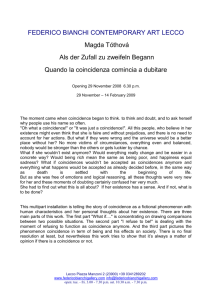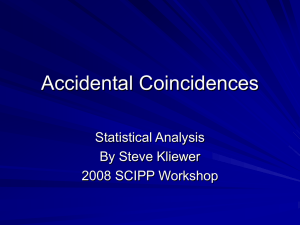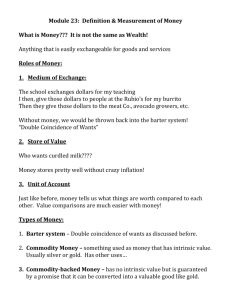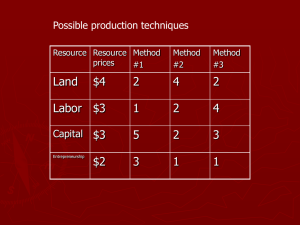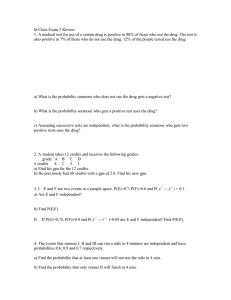COINCIDENCE CLASSES IN NONORIENTABLE MANIFOLDS
advertisement
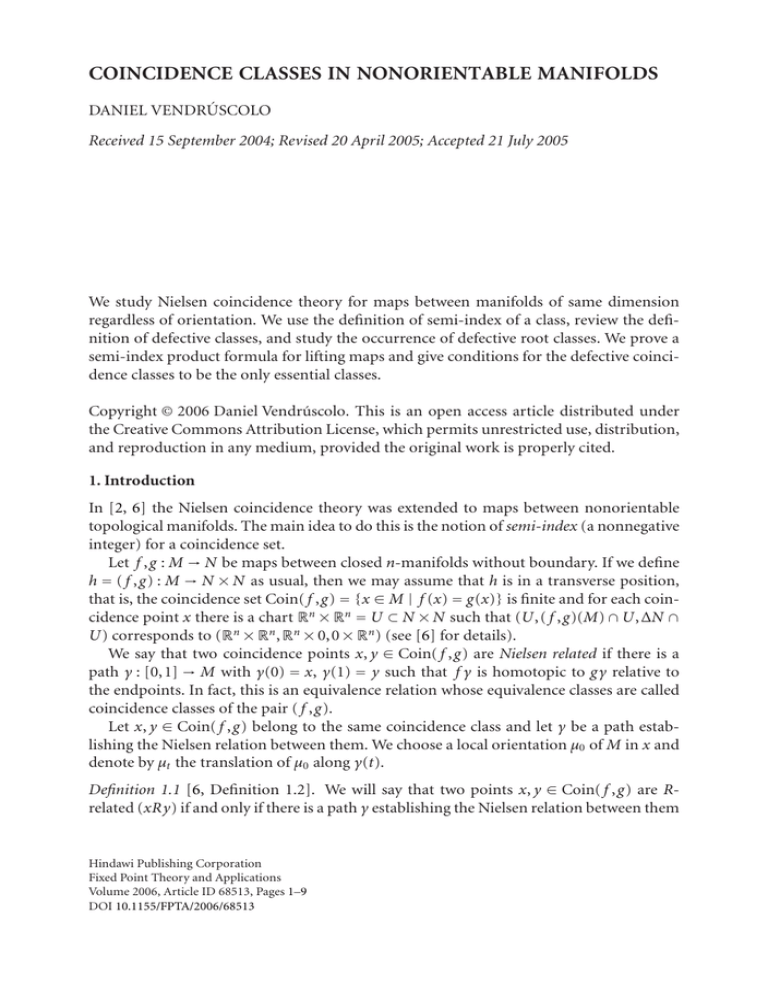
COINCIDENCE CLASSES IN NONORIENTABLE MANIFOLDS
DANIEL VENDRÚSCOLO
Received 15 September 2004; Revised 20 April 2005; Accepted 21 July 2005
We study Nielsen coincidence theory for maps between manifolds of same dimension
regardless of orientation. We use the definition of semi-index of a class, review the definition of defective classes, and study the occurrence of defective root classes. We prove a
semi-index product formula for lifting maps and give conditions for the defective coincidence classes to be the only essential classes.
Copyright © 2006 Daniel Vendrúscolo. This is an open access article distributed under
the Creative Commons Attribution License, which permits unrestricted use, distribution,
and reproduction in any medium, provided the original work is properly cited.
1. Introduction
In [2, 6] the Nielsen coincidence theory was extended to maps between nonorientable
topological manifolds. The main idea to do this is the notion of semi-index (a nonnegative
integer) for a coincidence set.
Let f ,g : M → N be maps between closed n-manifolds without boundary. If we define
h = ( f ,g) : M → N × N as usual, then we may assume that h is in a transverse position,
that is, the coincidence set Coin( f ,g) = {x ∈ M | f (x) = g(x)} is finite and for each coincidence point x there is a chart Rn × Rn = U ⊂ N × N such that (U,( f ,g)(M) ∩ U,ΔN ∩
U) corresponds to (Rn × Rn , Rn × 0,0 × Rn ) (see [6] for details).
We say that two coincidence points x, y ∈ Coin( f ,g) are Nielsen related if there is a
path γ : [0,1] → M with γ(0) = x, γ(1) = y such that f γ is homotopic to gγ relative to
the endpoints. In fact, this is an equivalence relation whose equivalence classes are called
coincidence classes of the pair ( f ,g).
Let x, y ∈ Coin( f ,g) belong to the same coincidence class and let γ be a path establishing the Nielsen relation between them. We choose a local orientation μ0 of M in x and
denote by μt the translation of μ0 along γ(t).
Definition 1.1 [6, Definition 1.2]. We will say that two points x, y ∈ Coin( f ,g) are Rrelated (xRy) if and only if there is a path γ establishing the Nielsen relation between them
Hindawi Publishing Corporation
Fixed Point Theory and Applications
Volume 2006, Article ID 68513, Pages 1–9
DOI 10.1155/FPTA/2006/68513
2
Coincidence classes in nonorientable manifolds
such that the translation of the orientation h∗ μ0 along a path in the diagonal Δ(N) ⊂
N × N homotopic to hγ in N × N is opposite to h∗ μ1 . In this case the path γ is called
graph-orientation-reversing.
Since ( f ,g) is transverse, Coin( f ,g) is finite. Let A ⊂ Coin( f ,g), then A can be represented as A = {a1 ,a2 ,...,as ; b1 ,c1 ,...,bk ,ck } where bi Rci for any i and ai Ra j for no i = j.
The elements {ai }i of this decomposition are called free.
Definition 1.2. In the above setup the semi-index of the pair ( f ,g) in A = {a1 ,...,as ;
b1 ,c1 ,...,bk ,ck } is the number of free elements s denoted by |ind|( f ,g;A) of A.
This definition makes sense, since it does not depend on a decomposition (c.f. [2,
6]). Moreover the semi-index is homotopy invariant, it is well defined for all continuous
maps, and if U ⊂ M is an open subset such that Coin( f ,g) ∩ U is compact, we can extend
this definition to that of the semi-index of a pair on the subset U, which is denoted by
| ind |( f ,g;U).
Definition 1.3. A coincidence class C of a transverse pair ( f ,g) is called essential if
| ind |( f ,g;C) = 0.
In [5] Jezierski investigates whether a coincidence point x ∈ Coin( f ,g) satisfies xRx.
Such points can occur only when M or N are nonorientable, in which case they are called
self-reducing points. This is a new situation (see [5, Example 2.4]) that cannot occur neither in the orientable case nor in the fixed point context.
Definition 1.4 [5, Definition 2.1]. Let x ∈ Coin( f ,g) and let H ⊂ π1 (M), H ⊂ π1 (N)
denote the subgroups of orientation-preserving elements. We define
Coin( f# ,g# )x = α ∈ π1 (M,x) | f# (α) = g# (α) ,
Coin+ ( f# ,g# )x = Coin( f# ,g# )x ∩ H.
(1.1)
Lemma 1.5 [5, Lemma 2.2]. Let f ,g : M → N be transverse and x ∈ Coin( f ,g). Then xRx if
and only if Coin+ ( f# ,g# )x = Coin( f# ,g# )x ∩ f#−1 (H ) (in other words, if there exists a loop α
based at x such that f α ∼ gα and exactly one of the loops α or f α is orientation-preserving).
Definition 1.6. A coincidence class C is called defective if C contains a self-reducing point.
Lemma 1.7 [5, Lemma 2.3]. If a Nielsen class C contains a self-reducing point (i.e., C is
defective), then any two points in this class are R-related, and thus
| ind |( f ,g;C) =
⎧
⎪
⎨0
if #C is even;
⎪
⎩1
if #C is odd.
(1.2)
Daniel Vendrúscolo 3
2. The root case
In [1] we can find a different approach to extend the Nielsen root theory to the nonorientable case. They use the concept of orientation-true map to classify maps between manifolds of the same dimension in three types (see also [7, 8]).
Definition 2.1. A map f is orientation-true if for each loop α ∈ π1 (M), f α is orientationpreserving if and only if α is orientation-preserving.
Definition 2.2 [1, Definition 2.1]. Let f : M → N be a map of manifolds. Then three types
of maps are defined as follows.
(1) Type I: f is orientation-true.
(2) Type II: f is not orientation-true but does not map an orientation-reversing loop
in M to a contractible loop in N.
(3) Type III: f maps an orientation-reversing loop in M to a contractible loop in N.
Further, a map f is defined to be orientable if it is of Type I or II, and nonorientable
otherwise.
For orientable maps they describe an Orientation Procedure [1, 2.6] for root classes.
This procedure uses local degree with coefficients in Z. For maps of Type III the same
procedure is possible only with coefficients in Z2 . Then they define the multiplicity of a
root class, that is an integer for orientable maps and an element of Z2 for maps of Type
III.
Now if we consider the root classes of a map f as the coincidence classes of the pair
( f ,c) where c is the constant map, we have.
Theorem 2.3. Let f : M → N be a map between closed manifolds of the same dimension,
without boundary.
(i) If f is orientable, then no root class of f is defective.
(ii) If f is of Type III, then all root classes of f are defective.
Proof. If f is orientable and α is a loop in M, f α ∼ 1 implies that α is orientationpreserving. On the other hand by Lemma 1.5, a coincidence class C of the pair ( f ,c)
is defective if and only if there exists a point x ∈ C and a loop α at x such that f α ∼ 1 and
α is orientation-reversing.
Now if f is a Type III map, then there exists a loop α ∈ π1 (M,x0 ) such that α is
orientation-reversing and f α ∼ 1. Let x ∈ Coin( f ,g) be a root. We fix a path β from x
to x0 . Then γ = βαβ−1 is a loop based at x, orientation-reversing and f γ ∼ 1. Thus x is a
self-reducing root.
In fact [1, Lemma 4.1] shows the equality between the multiplicity of a root class and
its semi-index.
Theorem 2.4. Let M and N be closed manifolds of the same dimension, without boundary
such that M is nonorientable and N is orientable. If f : M → N is a map, then all essential
root classes of f are defective.
4
Coincidence classes in nonorientable manifolds
Proof. There is no orientation-true maps from a nonorientable to an orientable manifold.
If f is a Type II map then by [1, Lemma 3.10] deg( f ) = 0 and f has no essential root
classes. The result follows by Theorem 2.3.
We use the ideas of Theorem 2.3 to state.
Lemma 2.5. Let f ,g : M → N be two maps between manifolds of the same dimension. If
there exist a coincidence point x0 and a graph-orientation-reverse loop α based in x0 such
that f α is in the center of π1 (N, f (x0 )), then all coincidence points of the pair ( f ,g) are
self-reducing points.
Proof. Let x1 ∈ Coin( f ,g). We fix a path β from x0 to x1 and we will show that for the
loop γ = β−1 αβ, the loops f γ and gγ are homotopic and γ is orientation-reverse. In fact
f γ ∼ gγ means f β−1 · f α · f β ∼ gβ−1 · gα · gβ hence f α · ( f β · gβ−1 ) ∼ ( f β · gβ−1 ) · gα.
The last holds, since the homotopy class of f α ∼ gα belongs to the centre of π1 (N, f (x0 )).
On the other hand γ = β−1 · α · β is orientation-reverse, since so is α.
Corollary 2.6. Let f ,g : M → N be two maps between manifolds of the same dimension
such that f# (π1 (M)) is contained in the center of π1 (N). If ( f ,g) has a defective class, then
all classes of ( f ,g) are defective.
In particular this is true for π1 (N) commutative.
3. Covering maps
Let M and N be compact, closed manifolds of the same dimension, let f ,g : M → N be
→ M and q : N
→ N be finite regular
two maps such that Coin( f ,g) is finite, and let p : M
of the pair f ,g:
→N
coverings such that there exist lifts f , g : M
M
f
g
N
M
(3.1)
q
p
f
g
N
Under such hypotheses there is a bijection between the set of Deck transformations,
of the covering space M
and the group (π1 (M))/(p# (π1 (M))).
D(M),
We fix a point x0 ∈
M and for each Deck transformation α we choose a path γ in M, from x0 to α(x0 ). Then,
if α is the projection of γ, the formula
π M, p x0
α −→ [α] ∈ 1
D(M)
x0
p# π1 M,
(3.2)
gives such bijection. It is easy to see that such bijection is an isomorphism of groups.
Daniel Vendrúscolo 5
The above isomorphism and a fixed lift f determine the homomorphism from the
to D(N)
for which the diagram
group D(M)
D(M)
f∗,x0
D(N)
(3.3)
π1 (M, p(x0 ))
x0 ))
p# (π1 (M,
f#
π1 (N, q( f (x0 )))
f (x0 )))
q# (π1 (N,
commutes. This homomorphism is given by the equality
f∗,x0 (α) f(x) = fα(x),
∀
∀α ∈ D(M),
x ∈ M.
(3.4)
The same construction can be done for map g and we have the following.
Then α(x0 ) ∈ Coin( f, g) if and only if
Lemma 3.1. Let x0 ∈ Coin( f, g) and α ∈ D(M).
f∗,x0 (α) = g∗,x0 (α) where x0 = p(x0 ).
Corollary 3.2. Let x0 ∈ Coin( f, g) and x0 = p(x0 ). Then p−1 (x0 ) ∩ Coin( f, g) have exactly #Coin( f∗,x0 , g∗,x0 ) elements.
Lemma 3.3. Let x0 and x0 be two coincidences of the pair ( f, g) such that p(x0 ) = p(x0 ) =
such that γ(x0 ) = x0 . The points x0 and x0 are
x0 , and let γ be the unique element of D(M)
in the same coincidence class of ( f, g) if and only if there exists γ ∈ π1 (M,x0 ) such that
x0 ))) corresponds to γ;
(i) [γ] ∈ (π1 (M,x0 ))/(p# (π1 (M,
(ii) f# (γ) = g# (γ).
Proof. (⇒) If x0 and x0 are in the same coincidence class of ( f, g), there exists a path β
from x0 to x0 establishing the Nielsen relation, (i.e., fβ ∼ gβ).
Take γ = pβ ∈ π1 (M,x0 ). We can see that [γ] = γ and f γ = q fβ ∼ qgβ = gγ, this
means that f# (γ) = g# (γ).
(⇐) The lift γ of γ starting at x0 is a path from x0 to x0 establishing the Nielsen relation,
(i.e., fγ ∼ gγ).
If γ is a loop in a manifold, we say that sign(γ) = 1 or −1 if γ is orientation-preserving
or orientation-reversing, respectively.
Corollary 3.4. In Lemma 3.3, if the points x0 and x0 are in the same coincidence class
of ( f, g), then x0 Rx0 if and only if sign( f∗,x0 (γ)) · sign(γ) = −1. In this case, x0 is a selfreducing coincidence point.
Proof. First we note that since f# (γ) = g# (γ), f∗,x0 (γ) = g∗,x0 (γ) and we have that
sign( f∗,x0 (γ)) · sign(γ) = −1 if and only if the paths γ and γ in the proof of Lemma 3.3
are both graph orientation-reversing.
and by Coin( f# ,g# )x0
If we denote by jx0 the natural projection from π1 (M,x0 ) to D(M)
the set {α ∈ π1 (M,x0 ) | f# (α) = g# (α)}, we have the following.
6
Coincidence classes in nonorientable manifolds
Corollary 3.5. If x0 is a coincidence of the pair ( f ,g), then the set p−1 (x0 ) ∩ Coin( f, g)
can be partitioned in (#Coin( f∗,x0 , g∗,x0 ))/(# jx0 (Coin( f# ,g# )x0 )) disjoint subsets, each of
them with # jx0 (Coin( f# ,g# )x0 ) elements all of them Nielsen related (therefore they are contained in the same coincidence class of the pair ( f, g)). Moreover, no two points of different
subsets are Nielsen related.
Lemma 3.6. Let x0 , x1 be coincidence points in the same coincidence class of the pair ( f ,g), α
be a path from x0 to x1 establishing the Nielsen relation, x0 , x0 coincidence points of the pair
such that γ(x0 ) = x0 .
( f, g) such that p(x0 ) = p(x0 ) = x0 , and γ the unique element of D(M)
If α and α are the two liftings of α starting at x0 and x0 respectively then:
(i) α(1) and α (1) are coincidence points of the pair ( f, g);
(ii) α(1) (α (1)) is in the same coincidence class as x0 (x0 );
(iii) p(α(1)) = p(α (1)) = x1 ;
(iv) γ(α(1)) = α (1).
(v) If α is a graph orientation-reversing-path (in this case x0 Rx1 ), then α and α are graph
orientation-reverse-paths (in this case x0 Rx1 and x0 Rx1 ).
Proof. (i), (ii), and (iii) are known (we prove using covering space theory). To prove (iv)
we notice that γ(α(0)) = γ(x0 ) = x0 = α (0) implies γ(α(1)) = α (1).
To prove (v), we use [2, Lemma 2.1, page 77].
Theorem 3.7. Let M and N be compact, closed manifolds of the same dimension, let f ,g :
→ M and q : N
→ N be finite coverings such that there
M → N be two maps, and let p : M
of the pair ( f ,g). If C is a coincidence class of the pair ( f, g), then
→N
exist lifts f , g : M
is a coincidence class of the pair ( f ,g) and
C = p(C)
⎧
⎪
⎨s · k(mod 2)
| ind | f, g; C =
⎪
⎩s · k
if C is defective;
(3.5)
otherwise,
where s = | ind |( f ,g,C), k = # j(Coin( f# ,g# )x0 ) and x0 ∈ C.
Proof. Since | ind | is homotopy invariant, we may assume that Coin( f ,g) is finite. The
is a coincidence class of the pair ( f ,g) is known. We choose a point
fact that C = p(C)
x0 ∈ C. Since Coin( f ,g) is finite, we can suppose C = {x1 ,...,xs ; c1 ,c1 ,...,cn ,cn } where
each xi is free, and for all pairs c j , cj we have c j Rcj .
Now we choose paths {αi }i , 2 ≤ i ≤ s; {β j } j and {γ j } j , 1 ≤ j ≤ n (see Figure 3.1) such
that
(i) αi is a path in M from x1 to xi establishing the Nielsen relation;
(ii) β j is a path in M from x1 to c j establishing the Nielsen relation;
(iii) γ j is a graph-orientation-reversing path in M from c j to cj .
Assume that C is not defective. We notice that p−1 ({c1 ,c1 ,...,cn ,cn }) ∩ C splits into the
γrj (0), γrj (1)} where γrj is the lift of γrj (0) starting from a point cri ∈ p−1 (ci ).
pairs of points {
By Lemma 3.6 (v) the points γrj (0), γrj (1) are R-related. For the same reason no two points
Daniel Vendrúscolo 7
βn
β1
αs
x1
α2
x2
···
γn
γ1
xs
c1
c1
···
cn
cn
Figure 3.1. The class C and the chosen paths.
from p−1 ({x1 ,...,xs }) are R-related. Thus
| ind | f, g; C = #p−1 {x1 ,...,xs } = | ind |( f ,g,C) · k = s · k.
(3.6)
Now we assume that C is defective. Then each point from C is self-reducing hence so
also is each point in C (Lemma 3.6 (v)). Now
= #C(mod
| ind |( f, g; C)
2)
= k(s + 2n)(mod2)
= k · s(mod 2).
(3.7)
4. Twofold orientable covering
Let M and N be compact closed manifolds of same dimension such that M is nonori → M be the
entable and N is orientable; let f ,g : M → N be two maps, and let p : M
→ N by f = f p and g = g p:
twofold orientable covering of M. We define f, g : M
M
p
M
f
(4.1)
g
f
g
N
Lemma 4.1. Under the above conditions, if C is a coincidence class of the pair ( f ,g), then
p−1 (C) ⊂ Coin( f, g) is such that
= p(C ) = C;
(1) p−1 (C) can be divided in two disjoint sets C and C , such that p(C)
(2) if x1 , x2 ∈ C (or C ), then x1 and x2 are in the same coincidence class of ( f, g);
(3) C and C are in the same coincidence class of the pair ( f, g) if and only if C is defective.
Proof. We make q : N → N as the identity map in the Corollaries 3.2, 3.4 and Lemma 3.6.
Corollary 4.2. Under the hypotheses of Lemma 4.1 we have
(1) if C is not defective, then C and C are two coincidence classes of the pair ( f, g) such
= − ind( f, g, C ) and | ind( f, g, C)
| = | ind |( f ,g,C);
that ind( f, g, C)
8
Coincidence classes in nonorientable manifolds
(2) if C is defective, then C ∪ C is a unique coincidence class of the pair ( f, g) with
ind( f, g, C ∪ C ) = 0.
Proof. It is useful to remember that the pair ( f, g) is a pair of maps between orientable
are the indices of the coincidence class C.
Since the index
manifolds and that ind( f, g, C)
and the semi index are homotopy invariants, we may assume that Coin( f ,g) is finite.
that is, the map exchang → M,
(1) Since M is nonorientable, the antipodism of A : M
−1
=
ing the points in p (x) reverses the orientation of M. On the other hand A(C)
−
1
−
1
= ind( fA , gA ; C)
= − ind( f, g; C).
C , hence ind( f, g; C ) = ind( f, g;A(C))
−1
(2) As above we deduce that for x, x ∈ p (x), ind( f , g; x) = ind( f , g; x ), hence ind( f,
g; p−1 (x)) = 0.
Corollary 4.3. Under de hypotheses of Lemma 4.1 we have
(1) L( f, g) = 0;
(2) N( f, g) is even;
(3) N( f ,g) ≥ (N( f, g))/2;
(4) if N( f, g) = 0, then all coincidence classes with nonzero semi-index of the pair ( f ,g)
are defective.
Proof. We have that p(Coin( f, g)) = Coin( f ,g), and in the pair ( f, g) the pre-image, by
p, of a defective class of the pair ( f ,g) has index zero.
5. Applications
Theorem 5.1. Let f ,g : M → N be two maps between closed manifolds of the same dimension such that M is nonorientable and N is orientable. Suppose that N is such that for all orientable manifolds M of the same dimension of N and all pairs of maps f ,g : M → N we
have that L( f ,g ) = 0 implies that N( f ,g ) = 0. Then all coincidence classes with nonzero
semi-index of the pair ( f ,g) are defective.
Proof. The hypotheses on N are enough to show, using the notation of the proof of
Lemma 4.1, that N( f, g) = 0. So by Corollary 4.3, all coincidence classes with nonzero
semi-index of the pair ( f ,g) are defective.
We notice that the hypotheses on the manifold N in Theorem 5.1, in dimension greater
than two, are equivalent to the converse of Lefschetz theorem. In dimension two these
hypotheses are not equivalent but necessary for the converse of Lefschetz theorem.
Remark 5.2. The following manifolds satisfy the hypotheses on the manifold N in
Theorem 5.1:
(1) Jiang spaces [3, Corollary 1];
(2) nilmanifolds [4, Theorem 5];
(3) homogeneous spaces of a compact connected Lie group G by a finite subgroup K
[3, Theorem 4].
Daniel Vendrúscolo 9
Acknowledgments
This work was made during a postdoctoral year of the author at Laboratoire Émile Picard,
Université Paul Sabatier (Toulouse, France). We would like to thank John Guaschi and
Claude Hayat-Legrand for the invitation and hospitality, Peter N.-S. Wong for helpful
conversations, and the referee for his critical reading and a number of helpful suggestions.
This work was supported by Capes-BEX0755/02-8 (International Cooperation CapesCofecub Project no. 364/01).
References
[1] R. F. Brown and H. Schirmer, Nielsen root theory and Hopf degree theory, Pacific Journal of Mathematics 198 (2001), no. 1, 49–80.
[2] R. Dobreńko and J. Jezierski, The coincidence Nielsen number on nonorientable manifolds, The
Rocky Mountain Journal of Mathematics 23 (1993), no. 1, 67–85.
[3] D. L. Gonçalves and P. N.-S. Wong, Homogeneous spaces in coincidence theory, Matemática
Contemporânea 13 (1997), 143–158, 10th Brazilian Topology Meeting (São Carlos, 1996), (P.
Schweitzer, ed.), Sociedade Brasileira de Matemática.
, Nilmanifolds are Jiang-type spaces for coincidences, Forum Mathematicum 13 (2001),
[4]
no. 1, 133–141.
[5] J. Jezierski, The semi-index product formula, Polska Akademia Nauk. Fundamenta Mathematicae
140 (1992), no. 2, 99–120.
, The Nielsen coincidence theory on topological manifolds, Fundamenta Mathematicae 143
[6]
(1993), no. 2, 167–178.
[7] P. Olum, Mappings of manifolds and the notion of degree, Annals of Mathematics. Second Series
58 (1953), 458–480.
[8] R. Skora, The degree of a map between surfaces, Mathematische Annalen 276 (1987), no. 3, 415–
423.
Daniel Vendrúscolo: Departamento de Matemática, Universidade Federal de São Carlos,
Rodovia Washington Luiz, Km 235, CP 676, 13565-905 São Carlos, SP, Brazil
E-mail address: daniel@dm.ufscar.br

